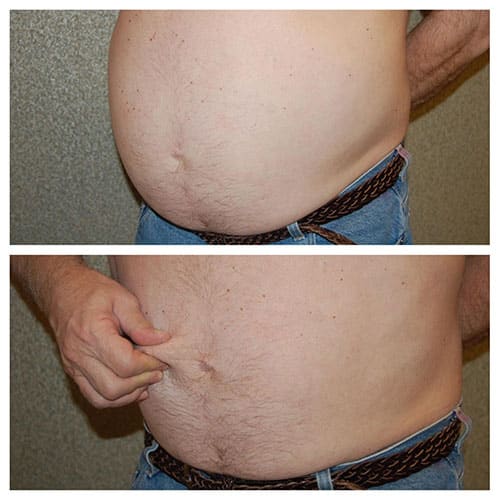Intra-abdominal fat is body fat that is located inside the abdominal cavity, and it can negatively affect our health and tummy tuck results. This educational writing discusses intra-abdominal fat and its role in abdominoplasty. It also will review what a person can do to improve this condition – including nutrition, exercise, and diet. This writing was done at the request of a woman who had a tummy tuck by me who resided in Dover, DE.
1- What is this inside or internal fat, and does it have health implications?
People tend to gain or collect fat in different locations. As we age or gain weight, fat tends to accumulate in different parts of our body. Some people are pear shaped and collect fat in the hips, love handles, thighs, and flanks. This is subcutaneous or outside fat. This is the fat you can pinch in your hands and grab on to. Other people tend to gain fat internally, centrally, or inside. This is also called intra-abdominal fat, internal fat, visceral fat, or central fat. These people tend to be apple shaped. This is the fat that has been believed to be a bigger cause of health concerns. This is the “bad” fat. This is the fat that is more closely linked to heart disease, diabetes, and other metabolic problems. This may be because the fat is internal and bathes the internal organs and metabolically is better positioned to cause harm.
It is thought the internal fat more directly exposes the internal organs and liver to free fatty acids and other pro-inflammatory factors. These factors are almost directly released into the portal vein of the liver. This leads to hepatic fat accumulation and negatively effects insulin metabolism. These are metabolic changes that are not healthy and can increase the chance of diabetes and other cardiac risk factors.
2- Losing intra-abdominal or internal fat:
However, there is good news about losing the internal fat. It tends to be the first fat lost with weight loss, diet, and exercise. This fat tends to shrink first and melt away first with weight loss. Loss of the internal fat has been shown to give benefits with cholesterol, blood pressure, and heart risks. The hardest fat to lose is the external fat, outside fat, or subcutaneous fat. The outside fat tends to be more resistant to exercise and weight loss. From a medical perspective, it’s good that the intra-abdominal fat or central fat is lost first, because this is the fat that is more dangerous to our health.
The outside fat is more resistant to weight loss and is the fat that makes us look bigger and fatter in the hips and thighs. Although this fat is resistant to exercise, it is this fat that can be removed surgically. This is the fat that can be treated with liposuction and liposculpturing. You can not surgically remove internal, visceral, or intra-abdominal fat. This fat is around the organs and could cause grave injury. The outside or subcutaneous fat is the exact area cosmetic surgeons target with liposuction. This fat is outside the muscles and is the fat easily removed with liposuction.
A doctor can recommend weight loss. It’s easy to say and hard to do. Diet, exercise, and weight loss are the cornerstones of getting rid of all fat. Regular exercise of moderate intensity is what I recommend. This should be 30 minutes a day, but 60 minutes if possible. Try and really sweat when working out. This means you are achieving a good aerobic exercise that is burning calories. Spot abdominal exercises have been shown to do nothing for internal fat. You can not “spot” weight loss.
For people interested in my recommendations for nutrition, they should link now to my writings on this topic. There are four writings that will educate the reader about the topic of nutrition and diet.
3- Intra-abdominal or visceral fat and its relationship to tummy tuck cosmetic surgery:
Visceral, central, or intra-abdominal fat can adversely affect tummy tuck results. This is the fat that is inside and can not be surgically removed. It is also the fat that can accumulate and act like an internal “bowling ball” of fat that pushes on the muscles. Some people can be almost pregnant with fat. This large amount of fat inside can put pressure on the muscle repair of an abdominoplasty. It can pull apart the repair and lead to suboptimal results. It can be a leading cause of disappointment from surgery patients. They know they have lots of “stomach” fat and want the surgery to “remove it all.” Yet, most of it is inside and can not be removed surgically. This person can end up with less dramatic results after the tummy tuck and have a greater chance of disappointment.
The “Diver Test” is a physical examination test to study the stomach area and its fat content. The person bends over at the waist about 30-40 degrees. The abdominal skin and fat are grabbed to assess the skin and fat excess. You can “pinch” the skin to see the fat amount. But now, do this a second time when you tighten your abdominal muscles. The tight muscles push the inside fat internally so we grab only the external or outside fat. This is the outside fat that is removed with an abdominoplasty or liposuction. People with large amounts of inside fat will find that the amount pinched is surprisingly little. This re-emphasizes that the cosmetic surgery can’t remove inside fat.
This photo shows a patient relaxing. He has a large amount of fat. Notice the top picture, he is in a relaxed posture. The second picture shows him contracting his abdominal muscles and pinching the skin. This shows how the great majority of his fat is internal fat. This fat is not good for liposuction, because it is inside the abdominal cavity. Weight loss will be best for this patient to remove this “bad” fat.
Please come in for a consultation. I practice exclusively cosmetic surgery and will review the topic with you in detail.


